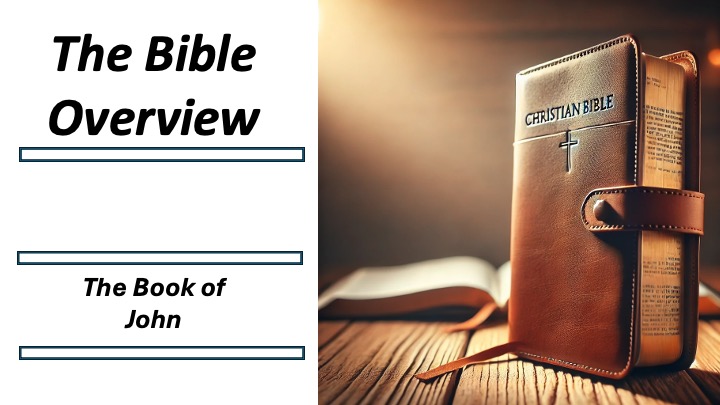Bible Overview John
Mike Ervin

Bible Overview – John
Authorship
- **Traditional
View**: Traditionally, the Gospel of John has been attributed to John the
Apostle, also known as John the Evangelist, who was one of the twelve apostles
of Jesus.
- **Modern
Scholarship**: Many modern scholars suggest that the Gospel was written by
someone within the Johannine community, a group of Christians who preserved and
transmitted the teachings attributed to John. Some scholars propose that it
could have been written by a disciple of John or an unknown elder within the
community.
Dates of
Authorship
- **Traditional
View**: Many early Christians believed that the Gospel was written between A.D.
90 and 100.
- **Modern
Scholarship**: Scholars generally agree with the traditional dating but suggest
a broader range, placing it from A.D. 70 to 110. Some argue for a slightly
earlier dating, closer to the destruction of Jerusalem in A.D. 70.
Intended
Audience
- **Traditional
View**: Early church tradition holds that John's Gospel was written for the
early Christian community as a whole, with particular emphasis on deepening the
faith of believers.
- **Modern
Scholarship**: Scholars often suggest it was aimed at a more specific audience,
possibly including both Jewish and Gentile Christians, to address issues of
belief and identity. It may have also engaged with a Hellenistic audience,
given its focus on themes like light and logos.
Major Themes
- **Divinity of
Christ**: The Gospel of John focuses heavily on the divine nature of Christ,
unlike the Synoptic Gospels, which emphasize his humanity.
- **Light and
Life**: Themes of light, life, and truth run throughout, emphasizing spiritual
enlightenment and eternal life through Christ.
- **Love and
Unity**: Love is a central commandment, stressing the importance of unity and
love among believers.
-
**Witness/Testimony**: The concept of testimony is prevalent, with Jesus, John
the Baptist, and the disciples all bearing witness to the truth.
- **Signs and
Miracles**: Unlike the synoptics, John calls Jesus’ miracles “signs,” which
serve to reveal his divine nature and authority.
Sequential
Review of Chapters
Here's a broad
overview of how you could examine the book chapter by chapter or in sections:
1. **Chapters 1-4:
The Beginning of Jesus' Ministry**
- Introduction with
the prologue (John 1:1-18), where Jesus is identified as the Word (Logos).
- Early signs and
interactions, including the wedding at Cana and Jesus’ conversation with
Nicodemus.
2. **Chapters 5-7:
Growing Controversy**
- The healing at
the pool of Bethesda and subsequent controversies over Jesus' authority.
- Jesus discusses
themes of life and judgment and begins to face significant opposition from
Jewish leaders.
3. **Chapters 8-12:
Conflicts and Revelations**
- Powerful
dialogues and confrontations, such as the woman caught in adultery and the
discourse on "the light of the world."
- Includes
narrative of raising Lazarus, which is pivotal in the escalating conflict.
4. **Chapters
13-17: The Farewell Discourse**
- Jesus’ final
moments with his disciples, teachings on the Holy Spirit, and the high priestly
prayer.
- Central focus on
love, unity, and preparation for the disciples’ mission after his departure.
5. **Chapters
18-21: Passion and Resurrection**
- Arrest, trial,
crucifixion, and resurrection of Jesus.
- Post-resurrection
appearances and the restoration of Peter.
Modern
Scholarship Considerations
Recent scholarly
discussions also examine the Gospel's links to the Qumran community,
Hellenistic influences, and its distinctive Christology. Theological and
literary-critical methods are employed to explore nuances within the text, such
as irony, symbolism, and narrative techniques unique to John.